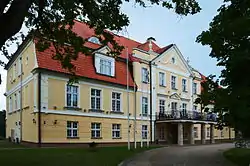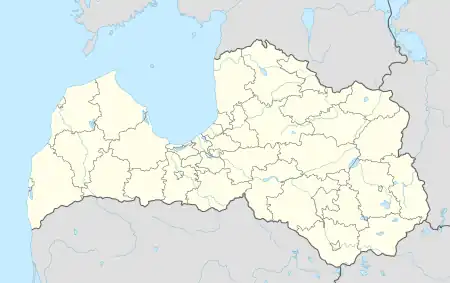Mālpils | |
|---|---|
Village | |
 Mālpils manor | |
 Mālpils Mālpils's location in Latvia | |
| Coordinates: 57°0′38″N 24°57′35″E / 57.01056°N 24.95972°E | |
| Country | |
| Municipality | Sigulda |
| Parish | Mālpils |
| Area | |
| • Total | 1.554 sq mi (4.025 km2) |
| Population (2020) | |
| • Total | 1,838 |
Mālpils (German: Lemburg) is a village in Mālpils Parish, Sigulda Municipality, Latvia.[1] Mālpils had 1,838 residents as of 2020.[2]
History
Between 1386 and 1413 the fortress Lemburg of the Teutonic Order was created. From the 15th century on there was a church. In 1577 the castle was occupied by troops of the Danish prince Magnus.
The village was built around the Good Lemburg, which was established after the Swedish conquest in 1622. Already before 1613, a Lutheran pastor is attested. In 1693 there was a community school.
The governor of Livonia Gustav von Taube became owner in 1760 and built larger parks. In 1766 a stone church was built. In 1845, many of the local peasants changed denominations and established a Russian Orthodox community. After the mansion had been burnt down during the Russian Revolution in 1905, a reconstruction in the classicist style began after the plans of Wilhelm Bockslaff. In 1920, the property was expropriated and divided into 166 farms for new settlers. The mansion served as a school and recreation home for soldiers.[3]
After the Second World War, there was a school for construction engineering and later the administration of a sovkhoz. During this time, the population, which in 1935 had still consisted of 279 inhabitants, grew to over 2500.
The restored estate buildings were opened in 2008 for the 150th anniversary of the architect Bockslaff and now serve as an exclusive hotel.[4]
Etymology
The place appears as Lehmborch (1466), Leemborch (1498), Lemborch (1530) and Latvian Mahlpils (1909) in documents.
The resident Liven called the place lembit-urga, which means something like "chief river". In terms of folklore, the German crusaders made it "Lehmburg". The Latvian name in turn is a translation: "clay castle" - Latvian Māls-Pils.
There are also stories that the Latvian peasants used to call the castle Mārpils because a girl named Māra was walled into the castle by Crusaders.[5][6]
Mālpils Novads (2009-2021)
The municipality of Mālpils was designated as Mālpils novads in 2009 as part of an administrative reform without territorial change. In addition to the main town are the villages Sidgunda (459 inhabitants), Upmalas (157 inhabitants), Vite (52 inhabitants) and Bukas (39 inhabitants) in the district. The remaining 4039 inhabitants (as of 2009) live on individual farms or in smaller settlements.[7]
The rivers Mergupe and Suda flow through the district, ending in the big Jugla. On the 220.9 km² large territory there are several wetlands with more than 1000 hectares.
Gallery
 Mālpils manor back
Mālpils manor back Location of former Mālpils castle
Location of former Mālpils castle Lutheran church in Mālpils
Lutheran church in Mālpils Cultural house
Cultural house
Notable people
- Johann Gottlieb von Wolff
- the alternative rock band aPēdājs.
References
- ↑ "Mālpils". Mālpils. Retrieved 2019-03-15.
- ↑ "Vietvārdu datubāze". vietvardi.lgia.gov.lv. Retrieved 2020-12-03.
- ↑ Baltisches historisches Ortslexikon. Feldmann, Hans., Zur Mühlen, Heinz von., Westermann, Gertrud. Köln: Böhlau. 1985–1990. ISBN 3412071838. OCLC 13332536.
{{cite book}}: CS1 maint: others (link) - ↑ "Mālpils". www.malpils.lv. Retrieved 2019-03-15.
- ↑ Enciklopēdija Latvijas pagasti : Latvijas pagasti, novadi, pilsētu un novadu lauku teritorijas. Iltnere, Astrīda. Rīgā. 2001–2002. ISBN 9984004120. OCLC 53951766.
{{cite book}}:|work=ignored (help)CS1 maint: location missing publisher (link) CS1 maint: others (link) - ↑ "Vietvārdu datubāze". vietvardi.lgia.gov.lv. Retrieved 2019-03-15.
- ↑ "Pilsonības un migrācijas lietu pārvalde - Kļūda 404" (PDF). www.pmlp.gov.lv. Retrieved 2019-03-15.